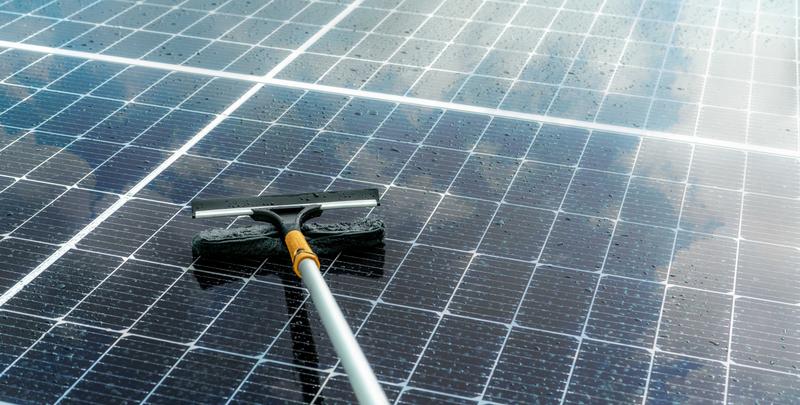
In case you’re hunting for a significant-general performance
Why Photo voltaic Panel Cleaning Matters
Photo voltaic panels capture Electrical power at their very best when cleanse. Dust, pollen, bird droppings, and smog minimize performance—from time to time by twenty% or even more. Normal cleaning helps sustain best functionality, increase panel life, and defend your expenditure.
Primary Gains:
- Improved energy output
- Decrease electricity expenses
- Extended panel lifespan
- Lessened chance of micro‑cracks resulting from thermal hotspots
Different types of Photo voltaic Cleaning Applications
Choosing the ideal Software relies on your setup, drinking water availability, and wanted convenience. Types incorporate:
- Drinking water‑powered photo voltaic brush devices
- Transportable solar panel cleaning package bundles
- Pure drinking water cleansing methods
- Rotary photo voltaic brushes and extension poles
Water Driven Photo voltaic Brush Devices
These brushes hook up with a drinking water source and spin while dispensing h2o, combining cleaning and lubrication in a single step. The result: spotless panels with out scratching.
Vital Capabilities:
- Built-in water feed from the brush head
- Comfortable bristles Protected for glass surfaces
- Rotary movement lowers manual exertion
- Mounts on extension poles for rooftop accessibility
Transportable Photo voltaic Panel Cleaning Kit
A whole solar panel cleansing kit usually features:
- Brush head (set or rotating)
- Extension pole (adjustable lengths as many as six m)
- Hose adapters or quick‑connect fittings
- Pure‑h2o tank or filtration process
- Tender microfiber towels or squeegees
- Non‑abrasive cleansing solution (if permitted)
Advantages of All-in-Just one Kits:
- Start off cleansing with minimum set up
- Compact for storage or travel
- Suitable with residential or business photo voltaic arrays
Pure Water Solar Cleansing Systems
These techniques purify local water—eradicating minerals and Grime—so it received’t leave scale or streaks. Pure h2o empowers Qualified-grade success devoid of chemical compounds.
How It Works:
- Pretreatment filtration (sediment, carbon, ion Trade)
- Closing deionization or reverse‑osmosis phase
- Filtered drinking water circulated by way of brush for cleansing
- Residue‑no cost drying—no places or streaks left at the rear of
Rotary Photo voltaic Brush & Extension Poles
For giant photo voltaic arrays or professional use, a power-rotating head on the telescoping extension pole would make cleansing economical and Secure.
Rewards:
- Fewer Actual physical hard work, a lot quicker protection
- Access roofs and ground‑mounted panels effortlessly
- Adjustable shaft lengths for different angles
- Universal quick‑join methods for equipment
Center on Basic safety & Very best Practices
Cleansing solar panels consists of heights and slippery surfaces—protection first:
- Use non‑conductive extension poles
- Avoid pressure washers that may crack glass
- Perform early or late to avoid glare and heat
- Don grips and slip-resistant sneakers
- Observe local drinking water‑use regulations or restrictions
Stage‑by‑Stage Cleaning Regimen
- Convert from the photo voltaic inverter or make sure program is deactivated
- Rinse panels with very low‑force h2o
- Make use of a brush (or solar brush kit) with h2o feed
- Scrub Carefully in overlapping, linear passes
- Rinse totally with cleanse drinking water
- Dry with microfiber squeegee or smooth towel—provided that required
Deciding on the Right Photo voltaic Panel Cleaning Tool
Consider your set up and also your h2o access:
Upkeep & Treatment Tips
- Flush hose and brush immediately after Every use
- Retail store dry, clean up, and away from UV exposure
- Exchange worn brush heads—and check bristle softness
- Inspect seals and connectors for leaks
- Exchange or cleanse filters in pure‑h2o units routinely
Eco-Friendly Cleaning Rewards
Proper cleaning prolongs solar panel effectiveness and decreases energy squander. Using h2o by itself—without the need of soaps or substances—can help protect regional ecology and avoids runoff pollution.
How Photo voltaic Panel Cleaning Impacts ROI
Good servicing using excellent brushes and kits keeps program performance topped up, decreasing the payback period of time and maximizing Electricity generate as time passes.
Charge Criteria & Benefit
- H2o‑run photo voltaic brushes are cost-successful and durable
- Pure water systems need upfront expenditure but give reliable, place‑cost-free cleaning
- Rotary brush kits Increase productivity—worthwhile for large installations
- DIY kits help you save labor fees; professional companies cost additional but release your time and energy
Widespread Makes use of of Photo voltaic Panel Brushes
- Household rooftops
- Professional photo voltaic farms
- RV or mobile installations
- Solar carports
- BIPV segments (building‑integrated photovoltaics)
Purchaser Testimonies & Use Conditions
“This photo voltaic panel cleansing brush created a recognizable distinction in minutes—dust absent, no streaks, and our output improved!”
“Upgrading to some drinking water‑powered photo voltaic brush saved several hours of scrubbing. Coupled with a pure drinking water process, the panels appeared new.”
FAQs About Photo voltaic Panel Cleaning
How often need to panels be cleaned?
Each individual 6 to twelve months, depending on your local climate—additional typically in dusty or pollen-large regions.
Can rain clean photo voltaic panels?
Rain can help but doesn’t remove Filth buildup or film levels—guide cleansing yields better overall performance.
Am i able to use faucet water?
Faucet water may well leave mineral residue. A
Can cleaning destruction panels?
Only if abrasive instruments or substantial-pressure washers are applied. Constantly use soft bristles, very low-stress, and abide by producer guidelines.
Pro Techniques for Photo voltaic Panel House owners
- Clean early early morning or night to stop thermal worry
- Keep track of output information—if functionality drops, clear panels
- Hold panels angled—standing drinking water promotes algae growth if remaining much too prolonged
- Rotate brush heads periodically to keep up even put on
solar panel cleaning kit
Summary: A Brush For each Need to have
Irrespective of whether you’re on the lookout for a value-successful
Check out the total line of brushes and equipment made specifically for photo voltaic cleaning at